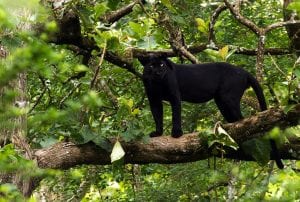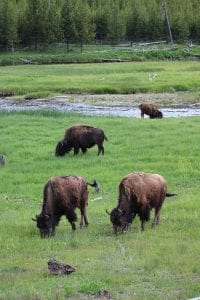What Factors Might Cause The Carrying Capacity Of A Population To Change
What Factors Decide the Carrying Capacity of an Ecosystem?
Carrying chapters, or the maximum number of individuals that an surroundings can sustain over time without destroying or degrading the surroundings, is determined by a few central factors: nutrient availability, water, and space. These fundamental factors accept the ability to limit, or even reduce a population by lowering birth rates, increasing the death rate, or encouraging migration. For this reason, these are referred to equally 'limiting factors.' When there are no limiting factors a population can abound exponentially.
Abiotic vs. Biotic Limiting Factors
These limiting factors tin can exist farther broken down into abiotic or biotic limiting factors. Abiotic factors are non-living physical and chemical elements in the ecosystem, such every bit sunlight, temperature, soil, water, and oxygen. Biotic factors are living or one time-living organisms in the ecosystem, such as food, illness, competition, and predators. Equally an example, we can look at bison in Yellowstone National Park. They accept to compete with elk and other ungulates while foraging for food, a biotic factor. One abiotic factor limiting bison is the weather, equally heavy winter snows can drive them out of the park.
Limiting Factors Based on Density
Nosotros tin also look at factors that determine conveying capacity in terms of their density-dependence. Density-dependent limiting factors brand the per capita growth rate decrease as the population increases. Density-dependent limiting factors tend to exist biotic, including factors such as food and affliction. For example, in a population of panthers, there is access to a stock-still amount of nutrient. When the population remains small there will exist enough of food for all panthers. When the panther population gets large enough the food may become insufficient, leading to competition among panthers, from this competition, panthers may starve, or die, and stop reproducing. As such, the per capita growth rate of the panther population may shrink or level off. Nutrient in this case is an example of a density-dependent limiting factor.

Density-independent limiting factors are factors that bear upon the per capita growth rate regardless of how dense a population is and include factors such every bit a overflowing, drought, and habitat destruction. Consider a flash flood occurs in the panther habitat. The flood has the ability to kill any panther that is in the wrong identify at the wrong time, contained of how many panthers are in the area. In this example, the flood, or natural disaster, is the density-independent limiting factor.
Limiting Factors and Humans
While food and water supply, habitat space, and contest with other species are some of the limiting factors affecting the carrying capacity of a given environment, in human being populations, other variables such as sanitation, diseases, and medical care are besides at play. Often, some variables are not equitably distributed among human populations with some consuming more than than others, and with abundance on the rise globally, human carrying capacity is neither static nor easy to calculate.
Instruction Conveying Capacity in the Classroom
Help your students understand carrying capacity by sharing the activity Panther Hunt where interim as panthers, students compete for limited "prey" resources in the classroom "surroundings." Or, Habitat Scramble where students act every bit individuals of species in a habitat trying to survive by collecting cards that correspond essential habitat resources and explore what happens when a habitat is disrupted.
Photo Credits: Bison herd grazing in Yellowstone: Euphoria42, A melanistic Indian leopard in Nagarhole National Park: Davidvraju
About Population Educational activity
Population Education provides K-12 teachers with innovative, easily-on lesson plans and professional development to teach virtually human population growth and its effects on the environment and homo well-being. PopEd is a programme of Population Connection. Learn More Nearly PopEd.
Source: https://populationeducation.org/what-factors-determine-the-carrying-capacity-of-an-ecosystem/#:~:text=While%20food%20and%20water%20supply,care%20are%20also%20at%20play.
Posted by: kylefractoggen.blogspot.com


0 Response to "What Factors Might Cause The Carrying Capacity Of A Population To Change"
Post a Comment